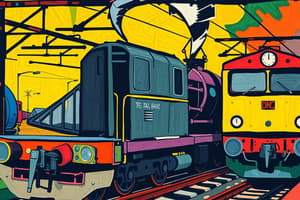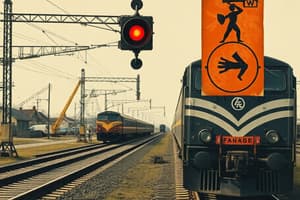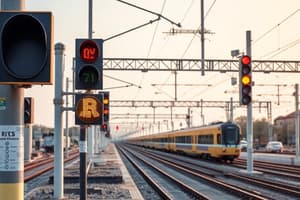Podcast
Questions and Answers
What does the indication 'Proceed; manual block clear' refer to?
What does the indication 'Proceed; manual block clear' refer to?
- Stop-signal
- Approach-medium
- Clear-block (correct)
- Absolute Clear
Which signal indicates to 'Proceed approaching next signal at Medium speed'?
Which signal indicates to 'Proceed approaching next signal at Medium speed'?
- Absolute Clear
- Stop-signal
- Medium-clear
- Approach-medium (correct)
What does the 'Stop-signal' indicate?
What does the 'Stop-signal' indicate?
- Proceed; track clear to next interlocking signal
- Proceed
- Stop (correct)
- Proceed; Medium speed within interlocking limits
Which signal allows for 'Proceed; track clear to next interlocking signal'?
Which signal allows for 'Proceed; track clear to next interlocking signal'?
What might happen when a portion of a signal is flashing?
What might happen when a portion of a signal is flashing?
What is the indication for 'Proceed; Medium speed within interlocking limits'?
What is the indication for 'Proceed; Medium speed within interlocking limits'?
Which signal is indicating 'Proceed' without any conditions?
Which signal is indicating 'Proceed' without any conditions?
What does a 'Clear-block' signal allow a train to do?
What does a 'Clear-block' signal allow a train to do?
What does the indication 'Absolute-Medium-clear' instruct a train to do?
What does the indication 'Absolute-Medium-clear' instruct a train to do?
What action is required when a train encounters the 'Approach-slow' signal?
What action is required when a train encounters the 'Approach-slow' signal?
What does 'Caution' indicate when approaching a switch?
What does 'Caution' indicate when approaching a switch?
What does the signal 'Flashing Slow-approach' instruct the train to do?
What does the signal 'Flashing Slow-approach' instruct the train to do?
What must a train do when it sees the 'Stop-signal' indication?
What must a train do when it sees the 'Stop-signal' indication?
What does the 'Restricting' signal indicate?
What does the 'Restricting' signal indicate?
When a train receives the 'Absolute-Slow-clear' signal, what is expected?
When a train receives the 'Absolute-Slow-clear' signal, what is expected?
What is the significance of the 'Block-limit' signal?
What is the significance of the 'Block-limit' signal?
What should trains do after passing an Advance Approach signal?
What should trains do after passing an Advance Approach signal?
What is the indication of a Stop-and-proceed signal?
What is the indication of a Stop-and-proceed signal?
What action should a train take when encountering a Medium Approach signal?
What action should a train take when encountering a Medium Approach signal?
What is the primary action required when a train sees a Stop Signal?
What is the primary action required when a train sees a Stop Signal?
Under what circumstances should a train proceed at Restricted Speed?
Under what circumstances should a train proceed at Restricted Speed?
What does the indication for 'Slow Proceed' signify for a train?
What does the indication for 'Slow Proceed' signify for a train?
What is the appropriate action when a train receives a 'Stop-signal' indication?
What is the appropriate action when a train receives a 'Stop-signal' indication?
What does the Clear Indicator signify regarding facing point switches?
What does the Clear Indicator signify regarding facing point switches?
What does the Stop board indicate?
What does the Stop board indicate?
What is the purpose of the Yard Limit board?
What is the purpose of the Yard Limit board?
When encountering a Caution Indicator, what action should the train take?
When encountering a Caution Indicator, what action should the train take?
What is indicated by a Train Order signal?
What is indicated by a Train Order signal?
What does the ASC Cut out signify?
What does the ASC Cut out signify?
What must a train do if it encounters a 'Yard Switch Indicator' showing red?
What must a train do if it encounters a 'Yard Switch Indicator' showing red?
When is the Standard Whistle Post used?
When is the Standard Whistle Post used?
What should a train do when approaching a 'Restricting' indication?
What should a train do when approaching a 'Restricting' indication?
What is indicated by the Quiet Zone Indicator?
What is indicated by the Quiet Zone Indicator?
What does the 'Approach Block-limit' indication instruct a train to do?
What does the 'Approach Block-limit' indication instruct a train to do?
What does the Clearance Point sign indicate?
What does the Clearance Point sign indicate?
Which statement accurately describes the Begin ASC sign?
Which statement accurately describes the Begin ASC sign?
What is the purpose of the Approach / Distant signal marker?
What is the purpose of the Approach / Distant signal marker?
What does the Delay in Block sign indicate to engineers?
What does the Delay in Block sign indicate to engineers?
What is the indication of the Permanent Speed Restriction sign?
What is the indication of the Permanent Speed Restriction sign?
What does the Begin MTEA sign represent?
What does the Begin MTEA sign represent?
What is the purpose of the Temporary Resume Speed sign?
What is the purpose of the Temporary Resume Speed sign?
Which type of signals are referred to as Zone 'A' signals?
Which type of signals are referred to as Zone 'A' signals?
What indicates that a train should approach the next signal at Limited speed?
What indicates that a train should approach the next signal at Limited speed?
How do Zone 'A' signals differ from Zone 'C' signals?
How do Zone 'A' signals differ from Zone 'C' signals?
When a train encounters a Temporary Advance Speed-limit sign, it indicates what?
When a train encounters a Temporary Advance Speed-limit sign, it indicates what?
Flashcards
Clear-block
Clear-block
Indicates the track ahead is clear and allows the train to proceed to the next signal.
Stop-signal
Stop-signal
This signal indicates that the train must stop. The track ahead is not clear.
Approach-medium
Approach-medium
This signal instructs the train to proceed at medium speed towards the next signal.
Medium-clear
Medium-clear
Signup and view all the flashcards
Absolute Clear
Absolute Clear
Signup and view all the flashcards
Flashing Signal
Flashing Signal
Signup and view all the flashcards
Signal Aspect
Signal Aspect
Signup and view all the flashcards
Signal Indication
Signal Indication
Signup and view all the flashcards
Slow-clear
Slow-clear
Signup and view all the flashcards
Absolute-Medium-clear
Absolute-Medium-clear
Signup and view all the flashcards
Slow-approach
Slow-approach
Signup and view all the flashcards
Approach-slow
Approach-slow
Signup and view all the flashcards
Restricting
Restricting
Signup and view all the flashcards
Stop-and-proceed
Stop-and-proceed
Signup and view all the flashcards
Restricting Proceed
Restricting Proceed
Signup and view all the flashcards
Slow Proceed
Slow Proceed
Signup and view all the flashcards
Approach Block-limit
Approach Block-limit
Signup and view all the flashcards
Caution Indicator
Caution Indicator
Signup and view all the flashcards
Clear Indicator
Clear Indicator
Signup and view all the flashcards
Yard Switch Indicator
Yard Switch Indicator
Signup and view all the flashcards
Stop Board
Stop Board
Signup and view all the flashcards
End of Block Board
End of Block Board
Signup and view all the flashcards
Yard Limit Board
Yard Limit Board
Signup and view all the flashcards
Begin ASC Board
Begin ASC Board
Signup and view all the flashcards
ASC Cut Out Board
ASC Cut Out Board
Signup and view all the flashcards
Standard Whistle Post
Standard Whistle Post
Signup and view all the flashcards
Quiet Zone Indicator
Quiet Zone Indicator
Signup and view all the flashcards
Spring Switch Marker
Spring Switch Marker
Signup and view all the flashcards
Limited Clear
Limited Clear
Signup and view all the flashcards
Advance Approach
Advance Approach
Signup and view all the flashcards
Medium Approach
Medium Approach
Signup and view all the flashcards
Slow-clear Signal
Slow-clear Signal
Signup and view all the flashcards
Approach-medium Signal
Approach-medium Signal
Signup and view all the flashcards
Absolute-Medium-clear Signal
Absolute-Medium-clear Signal
Signup and view all the flashcards
Stop-and-proceed Signal
Stop-and-proceed Signal
Signup and view all the flashcards
Absolute-Clear Signal
Absolute-Clear Signal
Signup and view all the flashcards
Permanent Speed Restriction Sign
Permanent Speed Restriction Sign
Signup and view all the flashcards
Begin MTEA Signal
Begin MTEA Signal
Signup and view all the flashcards
End MTEA Signal
End MTEA Signal
Signup and view all the flashcards
Study Notes
Long Island Rail Road Employee Training and Development - Signal Reference Manual
- This manual is for pre-employment training of engineer trainees
- Students are responsible for identifying signal names and indications
- Students are not responsible for notes during this training phase
- Signal identification is based on light aspects (position or color) or the whole signal flashing
- Flashing portions of a signal change its name and indication
- Examples of signal types used on the LIRR are provided
- Pedestal Light, Low Light, G-Head signal, Low Color Light, GCT Signal, 3 Head Color Light
Fixed Signals
- Students must identify signal names or aspects with 100% accuracy
- Signal aspects can be indicated by the position or color of the lights
- The entire or part of the signal may flash, altering its indication
- A flashing symbol on the signal indicates a flashing portion
Temporary Manual Block Signal
- Signal names, "Clear-block" and "Stop-signal"
- Indications for "Clear-block": Proceed; manual block clear
- Indications for "Stop-signal": Stop
Absolute Clear Signal
- Indication: Proceed; track clear to next interlocking signal. Approach next interlocking signal prepared to stop.
Approach-Medium Signal
- Indication: Proceed approaching next signal at Medium speed.
Medium-Clear Signal
- Indication: Proceed; Medium speed within interlocking limits.
Absolute-Medium-clear Signal
- Indication: Proceed; Medium speed within interlocking limits. Track clear to next interlocking signal. Approach next interlocking signal prepared to stop.
Approach-Slow Signal
- Indication: Proceed approaching next signal at Slow speed. Train exceeding Medium speed must at once reduce to that speed.
Approach Signal
- Indication: Proceed approaching next signal prepared to stop. Train exceeding Medium speed must at once reduce to that speed.
Caution Signal
- Indication: Train exceeding medium speed must at once reduce to that speed. Where a switch is connected with the signal, approach that switch prepared to stop. Approach next signal prepared to stop.
Slow-clear Signal
- Indication: Proceed; Slow speed within interlocking limits.
Absolute-Slow-clear Signal
- Indication: Proceed; Slow speed within interlocking limits. Track clear to next interlocking signal. Approach next interlocking signal prepared to stop.
Slow-approach Signal
- Indication: Proceed approaching next signal prepared to stop. Slow speed within interlocking limits.
Flashing Slow-approach Signal
- Indication: Train will proceed in accordance with signal indication within interlocking limits and after clearing the interlocking, proceed under absolute clear indication to the next interlocking.
Restricting Signal
- Indication: Proceed at Restricted speed.
Stop-and-Proceed Signal
- Indication: Stop; then proceed at Restricted speed.
Stop-Signal
- Indication: Stop
Block-limit Signal
- Indication: Limit of the block.
Absolute Proceed Signal
- Indication: Proceed; slow speed within interlocking limits. Track clear to next interlocking signal. Approach Next interlocking signal prepared to stop.
Proceed Signal
- Indication: Proceed, governed by cab signal indications.
Restricting Proceed Signal
- Indication: Proceed; restricted speed within interlocking limits, then governed by cab signal indications outside of interlocking limits.
Slow Proceed Signal
- Indication: Proceed; slow speed within interlocking limits, then governed by cab signal indications outside of interlocking limits.
Restricting Signal
- Indication: Proceed at Restricted speed.
Stop-signal
- Indication: Stop
Approach Block-limit Signal
- Indication: Proceed approaching next block-limit signal prepared to stop. Train exceeding Medium speed must at once reduce to that speed.
Stop signal/Train order Signal
- Indication: Stop/Orders
Train order Signal
- Indication: Orders
Distant Switch Indicator (DSI) - Caution Indicator
- Indication: Facing point switch(es) open. Trains exceeding Slow speed must at once reduce to that speed approaching switch or switches prepared to stop.
Distant Switch Indicator (DSI) - Clear Indicator
- Indication: Facing point switch(es) closed.
Yard Switch Indicator
- Indication: White: Switch normal, proceed at Restricted speed. Yellow: Switch reverse, proceed at Restricted speed. Red: Switch not normal or reverse, route must be verified. The Conductor or Engineer must examine the switch points to verify that the points fit the rail properly before movement may be made over switch at Restricted speed.
Main Track Switch Target
- Indication: For diverging route / Switch lined normal for main track
Stop board
- Indication: Stop then be governed by timetable special instructions, General Notice or Bulletin notice.
End of Block
- Indication: Train must operate in accordance with rule 153.
Yard limit board
- Indication: Main Track Yard limits.
Begin ASC
- Indication: Automatic speed control begins.
ASC Cut out
- Indication: Entering cut out loop.
Standard Whistle post
- Indication: Approaching crossings at grade for which rule 14L must be sounded.
Roadway Workers portable whistle post
- Indication: When roadway work is being performed in multiple track portions of the railroad, a white banner below the "W" on the yellow background shall be used to indicate the track occupied by the roadway workers for which rule 14L must be sounded as a warning.
Quiet Zone Indicator
- Indication: Approaching crossing at grade for which Rule 14L will not be sounded except as specified by Special Instruction.
Spring switch marker
- Indication: Spring switch.
Approach / Distant signal marker
- Indication: Visual reminder to engineers of trains that Rules 28B and 33B apply between the distant signal and the home signal.
Clearance Point sign
- Indication: The location at which equipment must clear to access a track(s) for facing point moves in the opposite direction.
Delay in block sign
- Indication: Visual reminder to engineers of trains that Rules 28B and 33B apply when a station stop is made at this station.
Permanent speed restriction sign
- Indication: Reduce speed as prescribed by timetable.
Temporary Speed Signs ----RULE 38A
- Temporary Advance Speed-limit sign / Temporary speed-limit sign / Temporary resume speed sign
Begin MTEA
- Indication: The location at which MTEA limits begin. Trains must operate in accordance with rule 155.
End MTEA
- Indication: The location at which MTEA limits end.
Approach Limited Signal
- Indication: Proceed approaching the next signal at Limited speed.
Limited Clear Signal
- Indication: Proceed at Limited Speed until entire train clears all interlocking or spring switches
Advance Approach Signal
- Indication: Proceed prepared to stop at the second signal. Trains exceeding Limited Speed must begin reduction to Limited Speed as soon as the engine passes the Advance Approach signal.
Medium Approach Signal
- Indication: Proceed prepared to stop at the next signal. Trains exceeding Medium Speed must begin reduction to Medium Speed as soon as the Medium Approach signal is clearly visible.
Restricting Signal (page 21)
- Indication: Proceed at Restricted Speed until the entire train has passed a signal displaying a more favorable aspect or entered non-signaled DCS territory.
Stop-and-proceed Signal (page 21)
- Indication: Stop; then proceed at Restricted speed.
Stop-Signal (page 21)
- Indication: Stop
GCM Signals
- Indication: Proceed, governed by cab signal indications.
Reduced Proceed Signal
- Indication: Proceed, governed by cab signal indications.
Stop and Proceed Signal
- Indication: Stop then proceed at Restricted Speed.
Stop Signal
- Indication: Stop
Tips (page 24)
- Signal diagrams and blank space for note-taking are provided.
Studying That Suits You
Use AI to generate personalized quizzes and flashcards to suit your learning preferences.



